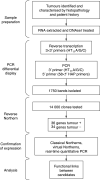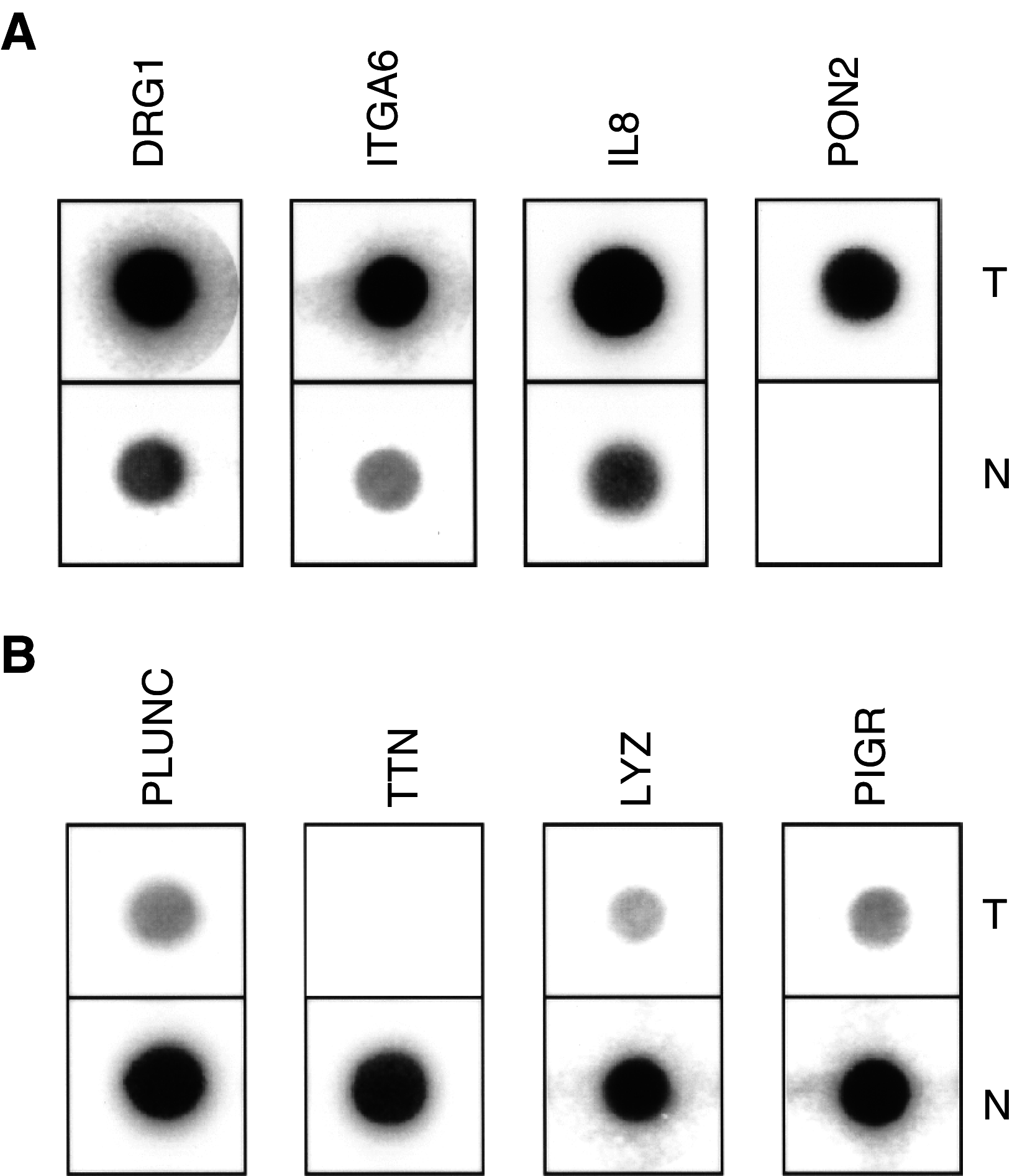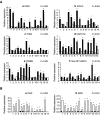Differential expression profiling of head and neck squamous cell carcinoma (HNSCC)
- PMID: 14612907
- PMCID: PMC2394447
- DOI: 10.1038/sj.bjc.6601373
Differential expression profiling of head and neck squamous cell carcinoma (HNSCC)
Abstract
Head and neck squamous cell carcinoma (HNSCC) is the fifth most common cancer in men with an incidence of about 780000 new cases per year worldwide and a poor rate of survival. There is a need for a better understanding of HNSCC, for the development of rational targeted interventions and to define new prognostic or diagnostic markers. To address these needs, we performed a large-scale differential display comparison of hypopharyngeal HNSCCs against histologically normal tissue from the same patients. We have identified 70 genes that exhibit a striking difference in expression between tumours and normal tissues. There is only a limited overlap with other HNSCC gene expression studies that have used other techniques and more heterogeneous tumour samples. Our results provide new insights into the understanding of HNSCC. At the genome level, a series of differentially expressed genes cluster at 12p12-13 and 1q21, two hotspots of genome disruption. The known genes share functional relationships in keratinocyte differentiation, angiogenesis, immunology, detoxification, and cell surface receptors. Of particular interest are the 13 'unknown' genes that exist only in EST, theoretical cDNA and protein databases, or as chromosomal locations. The differentially expressed genes that we have identified are potential new markers and therapeutic targets.
Figures






Similar articles
-
MicroRNA expression profile in head and neck cancer: HOX-cluster embedded microRNA-196a and microRNA-10b dysregulation implicated in cell proliferation.BMC Cancer. 2013 Nov 9;13:533. doi: 10.1186/1471-2407-13-533. BMC Cancer. 2013. PMID: 24209638 Free PMC article.
-
Expression profiles of miR-29c, miR-200b and miR-375 in tumour and tumour-adjacent tissues of head and neck cancers.Tumour Biol. 2016 Sep;37(9):12627-12633. doi: 10.1007/s13277-016-5147-2. Epub 2016 Jul 20. Tumour Biol. 2016. PMID: 27440205
-
The non-coding landscape of head and neck squamous cell carcinoma.Oncotarget. 2016 Aug 9;7(32):51211-51222. doi: 10.18632/oncotarget.9979. Oncotarget. 2016. PMID: 27323410 Free PMC article.
-
Expression of SESN1, UHRF1BP1, and miR-377-3p as prognostic markers in mutated TP53 squamous cell carcinoma of the head and neck.Cancer Biol Ther. 2017 Oct 3;18(10):775-782. doi: 10.1080/15384047.2017.1373212. Epub 2017 Sep 8. Cancer Biol Ther. 2017. PMID: 28886272 Free PMC article. Review.
-
Role of microRNA-138 as a potential tumor suppressor in head and neck squamous cell carcinoma.Int Rev Cell Mol Biol. 2013;303:357-85. doi: 10.1016/B978-0-12-407697-6.00009-X. Int Rev Cell Mol Biol. 2013. PMID: 23445815 Free PMC article. Review.
Cited by
-
Mutation and Transcriptional Profiling of Formalin-Fixed Paraffin Embedded Specimens as Companion Methods to Immunohistochemistry for Determining Therapeutic Targets in Oropharyngeal Squamous Cell Carcinoma (OPSCC): A Pilot of Proof of Principle.Head Neck Pathol. 2015 Jun;9(2):223-35. doi: 10.1007/s12105-014-0566-0. Epub 2014 Sep 19. Head Neck Pathol. 2015. PMID: 25236499 Free PMC article.
-
Sensitivity to Cisplatin in Head and Neck Cancer Cells Is Significantly Affected by Patient-Derived Cancer-Associated Fibroblasts.Int J Mol Sci. 2021 Feb 15;22(4):1912. doi: 10.3390/ijms22041912. Int J Mol Sci. 2021. PMID: 33671869 Free PMC article.
-
Immunohistochemistry, a valuable tool in detection of cervical lymph node micrometastases in head and neck squamous cell carcinoma: a prospective study.Indian J Otolaryngol Head Neck Surg. 2013 Jul;65(Suppl 1):89-94. doi: 10.1007/s12070-012-0551-4. Epub 2012 Mar 27. Indian J Otolaryngol Head Neck Surg. 2013. PMID: 24427623 Free PMC article.
-
Cell death in head and neck cancer pathogenesis and treatment.Cell Death Dis. 2021 Feb 18;12(2):192. doi: 10.1038/s41419-021-03474-5. Cell Death Dis. 2021. PMID: 33602906 Free PMC article. Review.
-
Molecular predictors of clinical outcome in patients with head and neck squamous cell carcinoma.Int J Exp Pathol. 2005 Dec;86(6):347-63. doi: 10.1111/j.0959-9673.2005.00447.x. Int J Exp Pathol. 2005. PMID: 16309541 Free PMC article. Review.
References
-
- Agarwala KL, Kokame K, Kato H, Miyata T (2000) Phosphorylation of RTP, an ER stress-responsive cytoplasmic protein. Biochem Biophys Res Commun 272: 641–647 - PubMed
-
- Ahmed N, Pansino F, Clyde R, Murthi P, Quinn MA, Rice GE, Agrez MV, Mok S, Baker MS (2002) Overexpression of alpha(v)beta6 integrin in serous epithelial ovarian cancer regulates extracellular matrix degradation via the plasminogen activation cascade. Carcinogenesis 23: 237–244 - PubMed
-
- Al Moustafa AE, Alaoui-Jamali MA, Batist G, Hernandez-Perez M, Serruya C, Alpert L, Black MJ, Sladek R, Foulkes WD (2002) Identification of genes associated with head and neck carcinogenesis by cDNA microarray comparison between matched primary normal epithelial and squamous carcinoma cells. Oncogene 21: 2634–2640 - PubMed
-
- Alevizos I, Mahadevappa M, Zhang X, Ohyama H, Kohno Y, Posner M, Gallagher GT, Varvares M, Cohen D, Kim D, Kent R, Donoff RB, Todd R, Yung CM, Warrington JA, Wong DT (2001) Oral cancer in vivo gene expression profiling assisted by laser capture microdissection and microarray analysis. Oncogene 20: 6196–6204 - PubMed
-
- Bar-Eli M (1999) Role of interleukin-8 in tumor growth and metastasis of human melanoma. Pathobiology 67: 12–18 - PubMed
Publication types
MeSH terms
Substances
LinkOut - more resources
Full Text Sources
Medical
Research Materials

